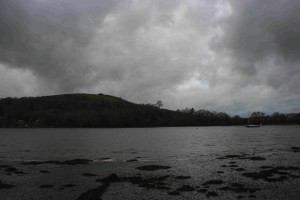
And still it rains, relentlessly, torrentially day in day out, week after week. We’ve become obsessed with the weather forecast tuning into radio and television at every opportunity, checking our phones, computers, tablets every hour. Low after low swirl across the Atlantic, bringing more and more severe flood warnings, leaving more and more devastation in their wake. Flooding, waterlogged fields, storm force winds, it feels as if the whole of the British Isles is sinking below the sea. As we travelled right across England from west to east last week to the memorial service of a dear friend, the roads seemed to snail their way like great grey slime trails across mile after mile of submerged farmland. The media tells of the desperate plight of the Somerset Levels but we saw the same in Avon, Wiltshire, North Oxfordshire, everywhere. And now it has reached us here in the West Country; the rail connection gone from Exeter to Penzance, Dawlish station washed away; catastrophe after catastrophe right across Devon and Cornwall.
Day in day out the forecast is the same; rain and wind, wind and rain. A brief respite and we rush to the yard to try to do a few long overdue jobs.
Then in comes the next storm. Gale force winds rock the very fabric of the buildings, trees sway precariously on the steep hills above us. No serious flooding here yet: no flooded barns or collapsing driveways so far this year. The flood defences we put in place after last years’ deluge are so far holding up. The stream is still just about contained as it roars through the valley. Frothing brown, it crashes its way to the mud streaked creek taking all in its path. Each high tide finds us cut off from the village as the huge volume of water coming off the hills is held back by gale force winds holding back the natural tidal flow of the river. The geese arrived last week but didn’t stay long this year. Resting and feeding for a while, they soon moved on.
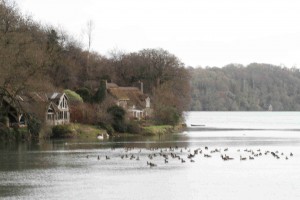
Day in day out, slipping and sliding on waterlogged ground, we trudge up to the top fields to feed the sheep. Today I could barely stay upright in the wind as I called the girls to tea. For once we are grateful to have such steep land where ewes can graze safely on high ground with a little barn for shelter.
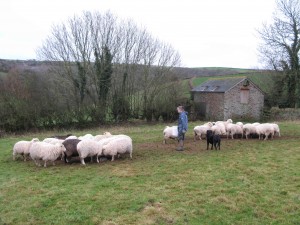
I heard on the radio the other day that someone somewhere has unearthed old records which show we are experiencing the highest rainfall since 1767, the year our house was built. As I watch our 21st century builders equipped with all the latest gear struggle to climb the scaffolding in howling winds and rain to mend our leaking roof and replace our rotten windows, I try to image the scene in the 18th century as men dug into the muddy Devon hillside in torrential rain toiling to build this strange, narrow four storey folly; a local Rector’s dream house for his daughter.

Some folly indeed, down a muddy track almost a mile from a steep riverside village, it stood at the head of a creek looking east towards the River Dart. There was a ford at the gate, no heating, no plumbing, certainly no little shop in the village! The village could only be reached on foot or by horse and cart, the local town by water. The only token to modernity, if you can call it that, were the coal grates in the house replacing he usual wood burning hearth. Coal barges unloaded their cargo at the head of the creek onto horse and carts so coal was available to warm the two main rooms; so very modern for 1767. But I keep imagining just how hard and bleak life must have been.
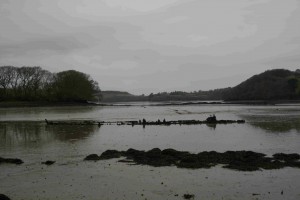 At the head of the creek the rotting hulk of the coal barge sinks into the mud
At the head of the creek the rotting hulk of the coal barge sinks into the mud
Dartmouth is still our nearest little town. A town with an extraordinary history, it has managed to re-invent itself in a quite remarkable way time and again across the centuries. It sits at the mouth of the Dart, a river which rises five hundred and fifty metres above sea level on the acidic peat bogs high up on Dartmoor. The water tumbles down fed by numerous little rivulets and streams until it becomes a respectable river flowing through grassland and heath, farmland and pasture to Totnes. Here it becomes an estuary, flooding a RIA valley formed long ago in the last Ice Age by rising sea levels and sinking land. It becomes tidal, freshwater mixing with salt from the sea. Oak trees dominate the shore. Dart is the Celtic word for “many oaks”.

Dartmouth perches at its mouth, a town with a history of ships and shipping and a story dominated by the sea. It was not until 1823 that the town became accessible by land for wheeled vehicles almost sixty years after our house was built. Up until that time only pack horses or ponies could manage the steep descent to town and .quay; the river was the motorway to the town.
In the 12th century Dartmouth was the fourth most important town in Devon after Exeter, Plymouth and Barnstaple. The First Crusade left in 1147 and the third in 1190. Dartmouth was already meeting the needs of commercial shipping. Smith Street, Higher Street and Lower Street formed the town centre on the water’s edge; merchant houses and warehouses backed onto the river making it easy to load and unload cargoes straight from ships. Boats lay alongside for repairs and the quay side was a thriving marketplace, the earliest recorded in 1231. Plenty of fresh water flowed from the hills above the town filling conduits which were still in use in the 20th century. The water supply made Dartmouth a popular place with brewers and vintners and in 1364 it received the Charter of Merchant Vintners increasing trade in cloth and herring as well as wine.
There were brewers, bakers, butchers and craftsmen. There was the pillory, stocks and a cucking stool in the waterside churchyard of St Saviours. Laws were plenty to dissuade the unscrupulous tradesman; a Millar must only have 3 hens and a cock in case he should feed client’s grain to his poultry. If he gave short weight he was fined for the first two offences then, if he offended again, he was into the pillory. A similar fate awaited the brewer who sold short measure. On his third offence it was into the cucking stool then into the pillory soaking wet; a nasty deterrent. And so on for the fishmonger and cook. Tavernier’s were forbidden to make their own wine and one Innkeeper who used his premises as a Brothel was simply expelled from the town.
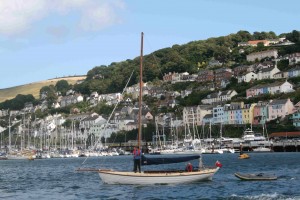 Until 1823 the river was the motorway of the town
Until 1823 the river was the motorway of the town
The strength behind the success of the town for many years was the great merchant and shipmaster, Hawley 1340-1408. It was he who fortified the town with a great chain that could be cast across the mouth of the river thus giving the town the power to stop enemy ships entering or leaving. So impressed was Chaucer when he met Hawley while visiting Dartmouth in his role as customs officer on behalf of the King in 1373, that he is believed to have based his famous Schipman upon him in the Canterbury Tales. Hawley’s achievements are legendry, mayor many times, a privateer of huge reputation and some say, possibly something of a pirate too. On his death the town mourned the loss of one of its greatest and began to decline.
But not for long, as the fishing trade increased so Dartmouth was to become famous for the Newfoundland fisheries. Sir Walter Raleigh, “a local”, described the fishery as “the mainstay of the West”. So important was it that the crews sailing to Newfoundland were exempt press-ganging into the Navy at times of war. The ships were away for half the year salting and drying the cod on board and trading it with goods from Spain, France and Portugal on their return en route to Dartmouth. As time passed fishing became more local and by the 18th century Devon boats were sending fish to Bristol, Bath, Portsmouth, London and the Channel Islands. The fish was kept alive in huge tanks on board ship.
Gradually the town began to change. It is hard to imagine Victoria Road under water until the beginning of the 19th Century; crossing places at North Ford and South Ford uniting the two small towns of Hardness and Clifton which together formed Dartmouth. Drainage and land reclamation began in earnest.
By the 1820’s Foss Street was dry land leading to the new Market Place. Wheeled vehicles began to come down the hill into the town at last. Local trade increased as farmers were able to bring more produce to market and supply local shops. Burgoyne’s the Butcher and Oldreive Brothers in Fairfax Place victualed the ships and fed the town. The display of poultry and game from the first floor of Oldreives was such that they employed staff all night to prevent “pilfering”.
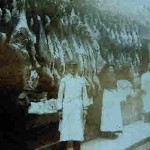
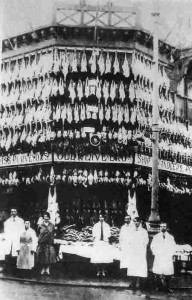
And so the town swung into the 20th then 21st century. Small traders like Mr Shillibeare and Mr Cutmore the butchers, Crisp and Green the greengrocers, Dave Killer the Chemist, Cundells the Grocer, have all given way to the supermarkets. There is just one butcher now run by the Pollards who cut up our lamb and pork so beautifully for our customers.
Jilly’s Farm Shop sells local produce every week day. High quality restaurants, cafes and pubs abound. The old bakery is gone but the fabulous patisserie, Saveurs has arrived from France. The old Market has recently been magnificently refurbished: the fat stock show and the farmers market keep the old traditions not just alive but thriving there, local food producers bring their produce to the town as they have done for centuries, then by boat, by cart or pack horse, now by car or van.
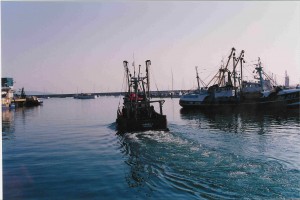
The fishing fleet mostly trade from nearby Brixham now but the crabbers still come, into the river and wonderful fresh fish is still available in abundance; local food producers are once more thriving and multiplying and local food is slowly being valued once again. Times change, and as in the past, Dartmouth adjusts to the needs of the moment; the multiplicity of a present built upon hundreds of years of the past.
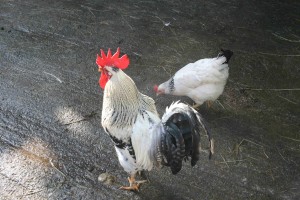
A delicious smell of chicken stock floats into the study as I write, the very last vestiges of a delicious local free range bird I bought from the Pollards last week. We’re hard to please when it comes to chickens having spent so many years raising table birds ourselves. But this was as good as anything we used to sell! And it provided so many meals. First I cooked traditional roast chicken. The following day a wonderful cold chicken salad, then a chicken and mushroom pie with added Hogs Pudding. The latter made by the aforesaid Richard Pollard even won the approval of by my Cornish husband! This evening a risotto and still to go, stock for soup, even scraps as a treat for the dogs! Not bad for one small chicken.
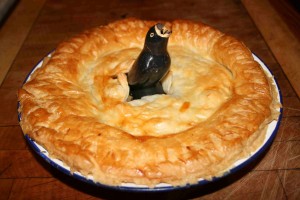
Left over chicken pie
Strip the last pieces of meat from the carcase. Use the bones to make stock for soup.
Finely chop a small onion or shallot in a little butter and oil (the oil stops the butter burning)
When the onion is soft but not coloured add sliced mushrooms, a little chopped bacon and Hogs Pudding if you can get it. It tends to be available only in the West Country.
Cook gently for a few minutes then stir in stock or left over gravy to a creamy consistency. Thicken with corn flour if necessary.
Add the chicken and some chopped parsley. Taste and season accordingly.
Tip into a pie dish. Cover with ready-made puff pastry. Brush with beaten egg and bake for till crisp and golden in a hot oven 200 c
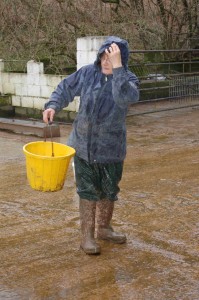
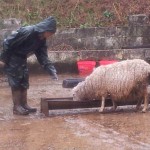
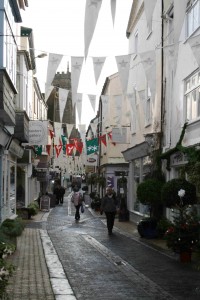
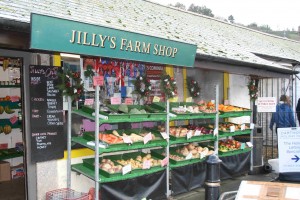
Leave a Reply